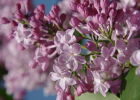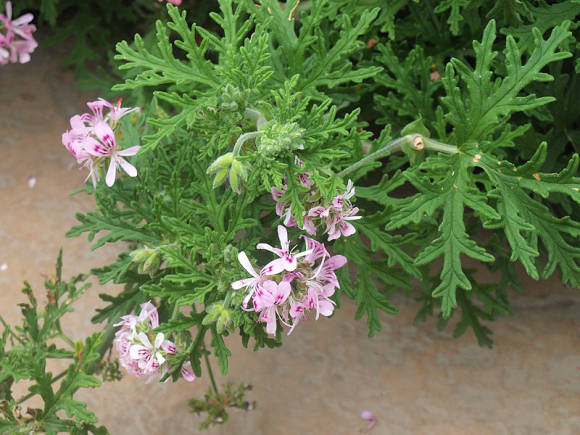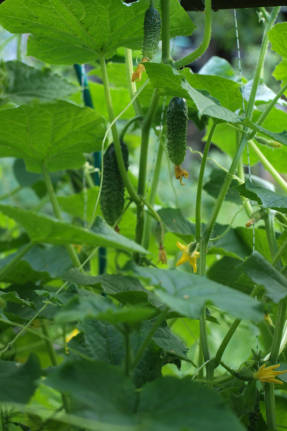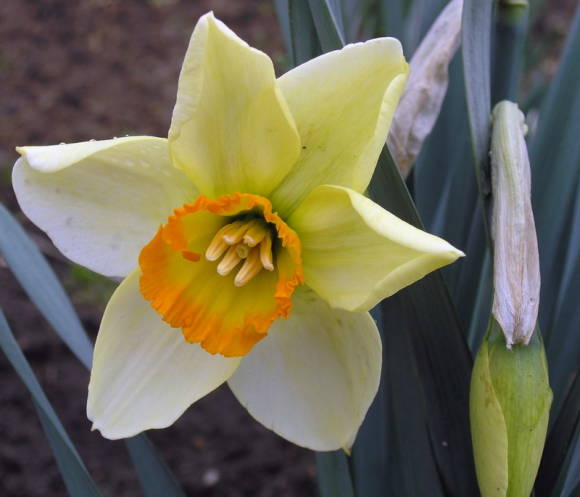The ending. Beginning in articles
Rare perennials in our garden
Rare perennials in our garden (continued)
Rare trees and shrubs in our garden
Rowan Köhne (Sorbuskoehneana) one of the three most beautiful mountain ash trees. In total, by the way, there are more than 240 species on Earth, and our common mountain ash (Sorbusaucuparia) among the first beauties not listed.
Rowan Kyone is a native of Central China. It is a small, straight, single-stemmed tree 2-2.5 (3) m high. The leaves are pinnate, of 17-25 leaves, very graceful. The bark is smooth, dark chestnut, with rare light brown lenticels.
 |
The tree is attractive for its general storage, but especially decorative during the periods of flowering and fruiting. It blooms in late May with white flowers about 1 cm in diameter, collected in umbrella-shaped brushes. Fruits with a diameter of 0.7-0.8 mm, unusual, porcelain-white color, colored at the beginning of August, finally ripening at the beginning of September. They are edible and have a sour taste.
The Köhne mountain ash is winter-hardy, sun-loving, drought-resistant, does not have any special soil preferences. All this makes the tree a welcome guest not only in private, but also in public landscaping. Undoubtedly, the rarity of Köne's mountain ash is temporary, and in the future the tree will take its rightful place in landscaping.
Sakura. Under the collective name "sakura", more than two hundred cultivars are grown in Japan, in the formation of which up to a dozen species from the genus took part Prunus (Cerasus).
The Japanese have a kind of religiosity, allowing the existence of an unlimited number of gods and shrines. The Japanese may have sacred not only the graves of historical figures or temples, but also stones, and water sources, and volcanoes ... They also have a number of sacred trees, which are usually planted in front of temples and at various places of worship. But sakura has a special place. She is not so much a sacred tree as the national symbol of Japan in general. Sakura for the Japanese means much more than any other plant for any other people.
 |
The Sakura Blossom Festival "Hanami" is one of the ancient Japanese holidays. Cherry blossoms have many meanings for the Japanese. It is also the personification of the spring rebirth of nature; and a sign of the temporality of our stay in this world; and a symbol of the commonality of all Japanese people in the face of danger. And what is very good for the unity of the nation, "Hanami" (as opposed to May 1!) Never had any "class" or party overtones.
In Japan, in general, they have a habit of endowing inanimate and living objects with all sorts of meanings. The blossoming of Japanese cherries (I know about this firsthand) is short-lived - yesterday morning the flower bud just opened, and tonight you found its petals lying at the foot of the bush. Who and when compared the brief moment of cherry blossom with the fleetingness of human life - I won't even guess. In medieval Japan, there was a dozen poets who praised the beauty of Japanese nature, including cherry blossoms. Initially, the poetic image of the cherry blossoms was adopted by Japanese professional warriors - samurai. Sakura became for them a symbol of courageous resistance to superior power. A brief moment of blossoming of a cherry tree meant a samurai's readiness as easily as sakura petals part with a tree, to part with life - if circumstances or the will of their master so require.
And when the "samurai" was abolished, the cherry blossoms were transformed into a symbol of the sacrifice of the entire Japanese people, for the sake of the interests of Japan and its emperor - the mikado. Sakura can be said to represent the Japanese spirit. A spirit of resistance to a force that cannot be defeated. What is this power? There may be an unpredictable force of the elements, because the Japanese have lived among volcanoes for thousands of years. The islands are shaking regularly, and tsunamis are constantly splashing on their shores.Or maybe we are talking about a strong adversary with a human face. Your enemy is obviously stronger than you, but this does not mean that you have to surrender! Fight to the last, fight while there is at least some strength, do not stop fighting, even if you received a mortal wound - die with dignity!
But the question arises - how can all Japanese people celebrate "Hanami" if the Japanese islands are located in the tropics and subtropics and in the temperate zone? It is quite obvious that this requires a whole set of "zoned" varieties. So it is - for each climatic zone, the Japanese have their own cherry blossoms. Their flowers are most often white or light pink. They can be plain or terry. The typical sakura is a tree the size of a small apple tree. But there are also quite large ones. For example, the popular park variety "Kanzan" has a height of up to 7-8 m, with a crown width of up to 15 m. And its flowers are pale pink, double. In "Hanami", the Japanese en masse (almost like a demonstration) go to their parks, where collective "picnics" are arranged under the umbrella-shaped crowns of such sakura
Since sakura is a popular, recognizable "brand", I have long wanted to have at least some Japanese cherry in my garden. We now have three Japanese sakura cherries in our collection. All of them grow in small bushes, not exceeding 2 meters in height. All three have simple flowers, all three courageously resist the superior force of the Russian winter: every year, although to varying degrees, they freeze, but do not freeze. They bloom sparsely and not every year. Note that these same varieties in Moscow already grow 3-4-meter trees and bloom quite abundantly.
Sakura agricultural technology is not difficult. They are sun-loving, drought-resistant, rather undemanding to soil conditions, but grow better on fertile, moderately moist, light loamy or sandy loam soils. Growing experience has led to the unequivocal conclusion that a good location is of paramount importance. The most favorable for Japanese women are the southern and western slopes. Protection from cold winds is essential. In this sense, the locations from the south of the buildings are especially good - "on the edge". And, undoubtedly, Sakura feels more comfortable in the city than outside the city.
And here's another thing. Having purchased sakura, do not expect that “admiring the cherry blossoms” (as the name of the holiday “Hanami” is deciphered) will now become for you the same usual spring event as for the Japanese. The achievement is that a real Japanese cherry tree grows under your window.
Boxwood evergreen "Blauer Heinz" ("BlauerHeinz») And hybrid boxwood«Aureovariegata». There is probably not a single lover of an ornamental garden who would not like to have an evergreen boxwood in the garden. And there seems to be nothing in it - only miniature leathery leaves. But how good they are, and how attractive the boxwood bushes themselves are. Boxwood is arguably the most abundant ornamental garden shrub on earth. It is enough to look at the topiary flowerbeds of palace and park ensembles in France and Holland to understand where this statement came from. After all, the device of even one flower bed requires dozens of boxwood seedlings. And in Versailles and Het Lu, you can measure the kilometers of running meters of boxwood borders.
Several boxwood cultivars have been growing in our garden for many years. We are no longer worried about their fate - since there are a lot of mother plants, and they have gone through many "bad" winters. The mothers, by the way, are planted in places with different microclimate: soil, illumination, in the city and outside the city, on level ground and on slopes, etc.
 |
Here we will talk about two box trees that appeared in our collection in 2001. Boxwood "Blauer Heinz" is everyone's favorite. This dwarf variety from Germany and in our middle lane has a good perspective. At home, it is the most popular boxwood variety among gardeners. And there are good objective reasons for that. "Blauer Heinz" grows in a very dense bush, all the shoots of which are directed upwards. The diameter and height of the bush usually does not exceed 20 (30) cm.The shape of the crown is almost spherical. The leaves of Blauer Heinz are small and have a pleasant bluish tint. Blauer Heinz is a wonderful curb shrub. Often, plants are simply planted in lines with an interval of 15-20 cm, and they are not cut at all, or cut minimally.
In addition to its high decorative qualities, Blauer Heinz pleasantly surprised us with its winter hardiness. It endures normal winters with little or no damage. In severe little snow it freezes slightly, but recovers rather quickly.
Genetic origin of the golden-motley boxwood "Aureovariegata"not clarified. Here it grows as a pyramidal bush up to 40 cm high, with a width of about 15 cm. The leaves are about 15 mm long, ovoid, with a slightly wavy edge. The variety, as expected, turned out to be thermophilic. He is permanently freezing, sometimes strongly, more often not very much. In snowless, harsh winters, some of the plants die. It hardly hibernates at all without damage. The plant needs a particularly favorable location: light shade from the midday sun, loose, moderately moist fertile soil with a pH of 7.0-7.5, and a complete absence of competitors.
Chinese lilac (Syringa × sinensis) has a complex hybrid origin and descended from Persian and common lilacs. Therefore, the specific epithet "Chinese" was given to this lilac by mistake. In fact, several varieties of this lilac with lilac-pink and white flowers are in circulation in the gardens of Russians under the name of Chinese lilac. They all keep the features of Persian lilac (Syringapersica), which, in turn, is a hybrid of Afghan lilac (Syringaafghanica). The natural habitat of Afghan lilacs is Afghanistan, North India and Iran. Phew!
 |
This lilac is good for many. She is small in stature - about 1/2 - 1/3 of the height of an ordinary lilac (in practice, her maximum height is 150-200 cm). And this opens the way for her to the flower and shrub front gardens, where the varieties of ordinary lilac are cramped. Despite its small stature, the flowers of Chinese lilacs are of the usual size for lilacs, although with their own special features. The Chinese lilac flower has a long thin tube, the petals are relatively narrow. The diameter of the corolla is 18-25 mm; flowers are collected in inflorescences of very diverse shape, often lumpy than pyramidal. The inflorescences of Chinese lilacs are distinguished by their delicacy, the flowers in them do not stick to each other, like in ordinary lilacs.
The bush itself in Chinese lilac grows more often single-barreled or in 2-3 trunks and does not form root shoots. The crown of the bush is rather rare, the shoots are thin Leaves 5-7 cm long, rich green, leathery, similar in shape to privet leaves, but with a sharply drawn tip.
A natural suspicion creeps in - since such a beauty has not yet occupied our gardens, she probably did not have a relationship with Santa Claus. What can I say to this? There is such a thing. Chinese lilac is really more thermophilic than common lilac. But not so much that the Russian winter turned on the red light in front of it. She, for example, is more winter-hardy than the next on this list Meyer's lilac, which, however, Russians do not ignore. Chinese lilacs endure ordinary winters very successfully, freezing only in severe and little snow. If you bring statistics to help, then out of three years in a row it blooms for two, and rests on the third.
Of course, lilacs with Afghan ancestors require most favored nation treatment. She is not demanding on the soil: what is good for ordinary lilacs will suit her. But the place must be chosen with particular pickiness. It should be completely exposed to the sun and dry enough. It is good if it is a southern or western slope; it is very good if from the north of the landing site there will be any structure - a house, a barn, etc.
Meyer's lilac (Syringameyerii) - in fact, Meyer's lilac is declared a shrub up to 150 cm high, but in our garden it has not grown to even 80 cm.It grows as a dense multi-stemmed bush, unless, of course, the word "trunk" is appropriate to use for shoots with a diameter slightly larger than a pencil.
 |
What kind of lilac is this, knee-deep !? Who needs it !? Oddly enough, many need some, no, but lilac. Gardeners today have gone not only literate, but also with imagination. Many no longer have gardens, but real dachas, albeit in the same partnerships. And six hundred square meters is only for the Japanese an endless field for creativity, for broad Russian people, thirty is not enough. After all, we need to equip a parking lot for two cars, a decent recreation area, and a guest house.
But there is a way to outwit everyone and turn your 6-hundredth allotment into a dimensionless one. What is an ornamental garden for? That's right - for eye delight! Garden beauty, meanwhile, has many options. You can, for example, go the Japanese way - the way of miniaturization and allegory. To begin with, instead of a "large-sized" lilac 3 meters high, plant a tiny Meyer lilac.
 |
But back to our baby. Of the hundreds of high school graduates who successfully passed the exam in biology, there is hardly at least one who, in a non-blooming state, will give Meyer's lilac the correct generic name - Syringa... And it's not just the size of the bush itself. Her leaves, both in shape and in size, are far from the usual lilac. Only bloom dot the i's. Meyer's lilac blooms a little later than common lilac and blooms for more than three weeks. The flowers are typical for lilacs - small, tubular, with an accrete four-petal corolla. They are pale pink in color, collected in small, up to 10 cm long, irregularly conical inflorescences. The flowers also have a scent, but not lilac, but rather lily of the valley.
By the nature of preferences, Meyer's lilacs are no different from other lilacs. Loves the sun, light, drained, but fertile enough soil. The weak point of Meyer's lilac is insufficient winter hardiness. To achieve sustainable flowering, it should be planted in a favorable place: on the south side of the house, on the southern slope or southwestern slope.
 |
Lying currant (moss) (Ribesprocumbens)... There is a small town Skovorodino in the Amur Region. As soon as his name is sounded (which happens very rarely), an associative array pops up in my memory - honest, disinterested people; pure pristine nature, moss currant ...
Mokhovka appeared in our collection at the very end of the last millennium, either in 1997 or in 1998. At that time, I actively exchanged plants with gardeners. So I started a correspondence with a certain resident of Skovorodino. I remember that she called her homeland "the land of evergreen tomatoes." In one of her letters, she said that in their area there is a creeping currant with a height less than a lingonberry. It grows exclusively on sphagnum bogs, growing into sphagnum, and almost not rising above the moss carpet, often continuous thickets. The local population walks on a moss, just as in "Russia" they walk on blueberries or lingonberries. Collecting moss is not difficult, because its berries grow in brushes and everything is in plain sight. Even an inexperienced collector is able to collect 2-3 buckets in a day. The moss berry is black, sweet and unusually aromatic. Where to her usual currants! Basically, "jam - five minutes" is made from moss.
All this was extremely interesting. Confused only by one fact - why such a beautiful berry bush has not yet been introduced into cultivation? Soon I received a parcel with neatly packed moss shoots. In an accompanying note, my correspondent wrote that she really hoped that I, as an experienced gardener, would be able to tame her. But at the same time, she expressed skepticism, since the locals had already transferred this shrub to their gardens a thousand times - all to no avail. "Mokhovka does not recognize anything but a swamp!"
- Well, we'll see, - I thought then, - They didn't break off such!
Meanwhile, disturbing thoughts began to swirl.What, in essence, does she want !? What is there in a swamp that is not in ordinary garden soil? Or, on the contrary, what of what is stuffed with cultural soil, is not in the wild sphagnum bog? It is clear that there is no sphagnum moss in the garden, it is striking. But in our garden there are such guests of sphagnum bogs as cranberries, wild rosemary, whitewash, blueberries. The simplest solution would be to plant the moss to your “fellow countrymen” on a peaty substrate specially recreated for them. In the end, they have a common mycorrhiza, maybe this also matters?
And so he did. Mokhovka did not refuse the proposed conditions. And it was already a success. But the main thing for which they go to the swamps for her, I never saw. That is, it grows to grow, and even blooms. And for some reason the fruits are not tied. Maybe she lacks some special pollinating insects? In general, there is still work to do.
Sumac fluffy, or deer-horned (Rhustyphina)... Using this exotic tree as an example, I was clearly convinced that woody plants of the same species can have different frost resistance. This shrub (I think the word tree is more suitable for its description) appeared in our collection around 1985. The books promised that sumac would grow into a small tree. But a decade has passed, and nothing but low (knee-high) overgrowth has been observed. I was disappointed. But then one of our customers said that in her garden, sumac is 3 meters high, and even blooms. She dug out the shoots of her sumac, and after some 5 years I myself had the pleasure of contemplating the exotic dense cones of its flowers. It is known that people get used to good things quickly. Now the sumac no longer causes that delight in me. It grows and grows by itself, without causing any worries.
 |
If we take into account the simple preferences of sumach, then it is a very unpretentious plant. It is sun-loving, drought-resistant, and even heat-resistant. And vice versa, sumac does not like waterlogging and does not tolerate stagnant moisture at all. Prefers light, sandy loam, deeply drained soils. It can tolerate skinny sand, but grows best on humus-rich substrates. As a good option, you can offer him a mixture of turf, humus and sand 1: 1: 3.
The specificity of sumach is that it is short-lived. A separate trunk lives for 7-9 years, reaches a diameter of 8-10 cm in the butt, after which it dies off, renewing itself with numerous shoots.
 |  |
Tamarix is graceful, bead (Tamarixgracilis). According to rough estimates, over the years of passion for the garden, at least 500 varieties and species of plants have died. How much money has flowed into the sand! But there were also those with whom I got even myself. For example, having experienced two different tamariks, with a cultivar of tamariks branched (Tamarixramosissima) parted without hesitation. He appeared with us first, promised to present with white beads, but only knew to drag out a miserable existence.
The second turned out to be more successful in all respects. He did not freeze like a tsutsik, in passing, in the second year he outgrew his forerunner, and by the age of 5 he reached his "design" height - 2.5 meters. But most importantly, he fully justified his specific epithet, and, without delay, already in the third year, revealed graceful bright pink flowers, collected in transparent panicles. Since then, it has been blooming without interruption, delighting with its wonderful beaded flowers and unusually long (from June to October!) Flowering.
A little about tamariks in general. This genus of shrubs of the tamarix family of the same name includes more than 75 species, of which 5-6 are found on the territory of Russia. The range of the genus is entirely located in the central belt of Eurasia and partly in North Africa - in the zone of steppes, semi-deserts and deserts. Tamariks are dry-loving, heat-resistant plants, and their entire "structure" is subordinated to the task of survival in conditions of moisture deficit. The leaves of tamariks look like miniature bluish-gray scales, resembling small needles or heather leaves. The shoots of the shrub are thin, twig-like, brittle with age.The flowers are small, white or pink, collected in delicate paniculate inflorescences. The abundant flowering of tamarix literally strikes with its originality. But even better are the half-open bush buds that look like pink or white balls - exactly like beads!
Tamarix is a southern plant, unknown to a resident of central Russia. Even his name is often presented here in two versions - tamarisk and tamarisk. But, oddly enough, this shrub cannot be blamed for being capricious. The main thing is to choose a suitable place for him. Tamarix is a typical desert inhabitant, he is a sun-lover and a dry-lover; in the center of Russia no drought can harm it. He lets his root straight into the depths of the soil. Therefore, the shrub absolutely does not tolerate close groundwater. By the way, because of the pronounced taproot, tamarix does not tolerate transplants in adulthood.
Based on the foregoing, tamarix should be planted in dry places with unattainable deep groundwater. You don't have to bother with the quality of the soil - tamarix does not need rich black soil. But it grows best of all on light-textured sandy loam or light loamy substrates with a thick sandy subsoil.
Despite the seeming exoticism, the most hardy tamarix cultivars could well be included in the assortment of public landscaping. In any case, he would definitely find a place in the city courtyards. It should be especially noted that tamariks are resistant to gas pollution and soil salinization, so they can be planted in the most problematic places from this point of view: on islets of road interconnections, slopes of highways, etc.
Photo by the author
Plants for the garden by mail.
Shipping experience in Russia since 1995
Catalog in your envelope, by e-mail or on the website.
600028, Vladimir, 24 passage, 12
Smirnov Alexander Dmitrievich
E-mail: [email protected]
Tel. 8 (909) 273-78-63
Online store on the site
www.vladgarden.ru









